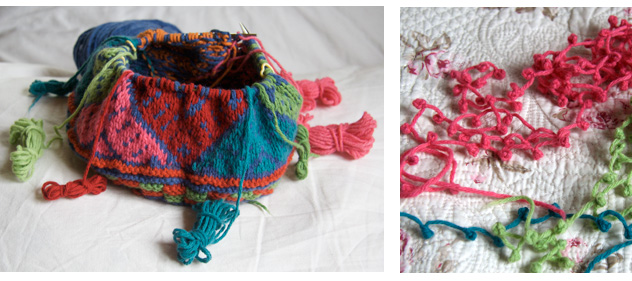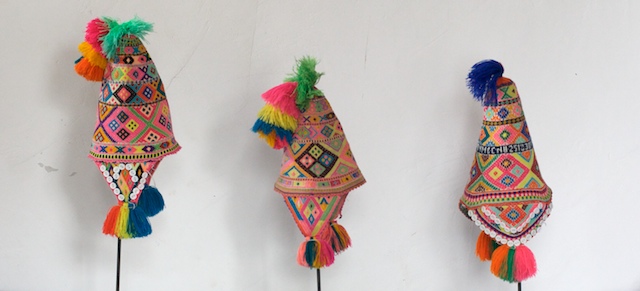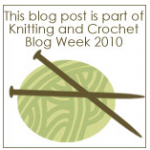I’ve been practicing my newly learned skills. On the left is the beginnings of a intarsia colorwork hat made with a corded join. We’re viewing it from the public side. It is actually made by purling from the inside. There are practical reasons for this, working from the “wrong side” it is easier to control all the little bobbins, and make sure they are properly twisted when encountering a new color. It is also easier to wrap every stitch if you’re obsessed enough to desire this elegant interior. I vacillate between making everything super tidy and amazing with every stitch twisted, to the slightly quicker stranding, which is pretty in its own way.
On the right we see a some grutas, or lumps….like you’d find in your oatmeal…only these will be soon be found adorning a sweet and cheerful baby hat. I’m making strands of grutas, a fairly new development in gruta technique. What at first seems tedious, quickly becomes habit forming. Practice at your niece’s soccer game, and you’ll be surprised how quickly your ribbons of grutas grow!
…now that I wrote that, maybe they were called grumitas, which I have written in my chicken-scratch notes in another place. When I look up in Google translator, I find bultitos for little lumps…any one out there know? In Quechua or Spanish?
Update!
reader Trudy says:
“I just looked up in my big Spanish dictionary – gruta is a “cavern or grotto”, grumo is translated as “lump” – as in a lump in sauce, or a clot 9(of blood), or cluster or bunch (of grapes). So I think it might be grumo – and the diminutive would be grumito(s)”
So you Spanish speakers and Andean textile experts can have a laugh on me…taking about making stranded grottos…which sounds kind of nice, really, like the hotsprings outside of San Miguel de Allende, that are linked pools from deep and cold following streams to warmer, all the way up to the final hot pool that is ….yes!…in a grotto. La Gruta…that must have been the source of my mistake.
Extra! I found I noted down “kurpa” when Phetra from Pitumarca was teaching me the knitted in variety…
Extra! Extra! Cindy found the translation for “kurpa”
| Runasimi (Quechua) – English |
adj. crisp
[Sikllalla Runasimi]
s. a flat clod of earth; clump; clump of earth; sphere; bullet; ball; clod of dirt; dirt clod
[Sikllalla Runasimi, Qosqo]
ta da!
I’m test-driving a workshop in these techniques this week in Boston.
I’ll also be informally demonstrating grutas at the Maine Fiber Arts booth at the Coastal Maine Botanical Gardens at this weekends Garden Fair: The Maine Gardeners and Artisan’s Festival. The festival will feature garden luminaries Eliot Coleman and Barbara Damrosch, woo hoo! I’ll be there Saturday and Sunday afternoon.





